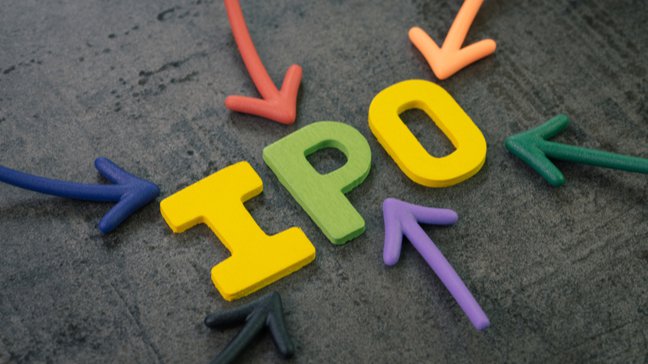An IPO (Initial Public Offering) is a special fundraising event that a private company goes through to become a public company. During an IPO, a private company sells new shares to public stock market investors with the help of an underwriter (i.e. an investment bank).
An IPO is a complex and complex process that typically takes six to nine months. Many of the world’s most profitable companies have gone through their own IPOs, and this represents a big achievement for any business’s growth trajectory.
Why do companies go for IPO?
A private company chooses an IPO for a variety of reasons. However, as a rule, there are several general factors that push private companies to IPO:
They want to grow faster and need more easily accessible money.
Source: Giphy.com
Companies tend to go public when they are in the growth stage. Fueling this often requires a large infusion of cash.
Listing also gives these companies easier access to money from investors on the open market in the future, as they can be raised through a subsequent sale of shares or debt offerings, which is more efficient than raising money privately. This is especially useful if a company wants to grow through an acquisition.
Early investors and employees want to cash out or get liquidity

Source: Giphy.com
By the time the company is ready to IPO or go public, it is likely that it has already received several rounds of funding from private investors such as venture capitalists.
On average, it takes about 5 years for a company in the US to go public after receiving private funding, so it makes sense that existing investors would want a greater return on their investment by taking on such high risk. An IPO is the perfect way to do this.
In addition, early employees and company founders may also want to finally cash in on the years of blood, sweat, and tears they put into building the business. Through an IPO, founders and employees who have stock options finally see the money they have invested in the company and can eventually sell their shares on the public market.
Read more: What you need to know if your job offers employee stock options
They want to increase their legitimacy and brand profile

Source: Giphy.com
An IPO is a big marketing event for a company that helps it become a bigger and more established business.
During the IPO process, a company, its products, leaders, and overall growth story receive significant media attention. This type of attention can attract new customers and new employees.
As a growing company, more media attention is usually a good thing (unless the IPO goes well…).
How does the IPO process work?
IPOs follow a structured process that begins with the selection of an underwriter (investment bank) to lead the deal.
The underwriter will then perform due diligence while lawyers create a document called a prospectus and file Form S-1 with the US Securities and Exchange Commission (SEC).
When this is done, the lead underwriter will create a deal syndicate, which is a group of peer underwriters who will help promote (or sell) the IPO to their clients. After blocking the syndicate and completing all financial and legal paperwork, the lead underwriter will begin the so-called “roadshow” of the company.
A road show is a typical IPO event. This allows company management to tell the story of their organization to potential investors who may want to buy shares in an IPO.
At the end of the road show, a price range for the IPO is set and interested investors submit their bids. To compensate early investors for the risk of investing, underwriters typically price the offer below what they think market demand will support. This creates an immediate jump in the price of the company’s stock or an “explosion” at the open. This is standard IPO practice.
If there is a lot of investor interest when the underwriters take orders, the IPO can become over-subscribed, which could push the price up even more before the opening.
The next day, the IPO company usually rings the bell on the exchange they are listed on to open the market and their shares start trading.
Read more: If you have invested in the IPOs of these companies, how rich are you today?
Are there other ways for companies to go public?
It is commonly believed that an IPO is the only way to become a public company, but this is not true. There are many ways for private companies to go public, each with its own pros and cons.
Direct Listing
A direct listing allows a company to go public without an investment bank/underwriter. Existing shareholders of the company are simply selling their shares on the public markets instead of having the bank do it for them.
Because a company’s goal in a direct listing is primarily to go public (rather than raise money by selling new shares), direct listings are generally a much faster and cheaper process and do not come with the usual lock-up periods like IPO.
Companies like Slack and Spotify that have enough money, are well-recognized brands, and have a clear business model are examples of companies that have gone through a direct listing instead of an IPO.
Reverse absorption (RTO)
A reverse takeover (or RTO) is a behind-the-scenes alternative for companies looking to go public when they don’t have the funding requirements and profile required for an IPO.
An RTO involves a private company buying a publicly traded shell company (a company with no active business operations or assets) and exchanging its shares for shares in a publicly traded company.
RTOs are usually a good option when there are no concerns about the existing shareholder base and if the company wants to move quickly without the cost of an IPO. Although they seem profitable, RTOs often pose more risk to investors than IPOs.
SPAC (special purpose acquisition company) or “blank check company”
Until recently, SPACs were all the rage when it came to going public. In 2020, 248 SPACs were launched, worth $83 billion, and in 2021, 613 SPACs were launched, worth $160 billion. From SoFi to Virgin Galactic, it seems like everyone has been using SPACs over the past few years.
To execute a SPAC, groups of investors raise money to invest in a publicly traded shell company and then look for a private company to buy (hence the “blank check company”). When investors sign up to invest in a SPAC, they often have no idea of the company that will eventually be acquired. Like other options, SPACs are faster than IPOs.
However, unlike IPOs, SPACs are far more risky than IPOs because investors are betting on the track record of the SPAC promoter rather than the business of a particular company. It also requires less regulatory disclosure and oversight, which means these types of transactions are more prone to hype or sometimes fraud.
Can I invest in an IPO?
Investing in an IPO is generally reserved for experienced investors and wealthy individuals. But, given the increased interest in investing in IPOs, more and more brokerage companies are beginning to offer their regular clients access to IPO shares.
TD AmeritradeCharles Schwab, E*TRADE, Robin Hood, and SoFi offer some access to IPO shares – provided you meet certain requirements. While you can now purchase shares in an IPO, keep in mind that doing so comes with significant risks.
Read more: The best stock trading apps
IPOs have historically underperformed the market for two and a half years after going public, and over 60% of IPOs between 1975 and 2011 showed negative absolute returns after five years. This is because companies that recently went public have significant growth expectations and tend to over-hype during the IPO process.
Also, there can be major differences in valuation in public and private markets, so when a company goes public, public investors may not give the company the same value as its private investors.
Finally, recently IPO companies often fail to turn a profit and find it difficult to become profitable quickly enough to meet the demands of public market investors.
If you don’t want to take the risk of investing in individual IPOs, there are ETFs (Exchange Traded Funds) available that allow you to invest in newly listed companies. Good examples of this are the First Trust US Equity Opportunities (FPX) ETF and the Renaissance IPO (IPO) ETF. But again, be careful when considering these types of investments as they are more volatile than the S&P 500.
Summary
An IPO is when a company “goes public” by selling new shares to investors on a public stock market. They are usually held when a company needs quick money to grow so that employees and founders can capitalize on their initial investment or build a company brand profile.
While investing in IPOs used to be only available to more sophisticated investors, more and more brokerages are offering IPO shares to investors of all levels. Just be aware that there is always a risk that an IPO will not live up to the hype.
Featured Image: eamesBot/Shutterstock.com
Read more:
Advertiser Disclosure – This advertisement contains information and materials provided by Robinhood Financial LLC and its affiliates (“Robinhood”) and MoneyUnder30, a third party not affiliated with Robinhood. All investments involve risk, and the past performance of a security or financial product does not guarantee future results or returns. Securities offered through Robinhood Financial LLC and Robinhood Securities LLC, which are members of FINRA and SIPC. MoneyUnder30 is not a member of FINRA or SIPC.”


